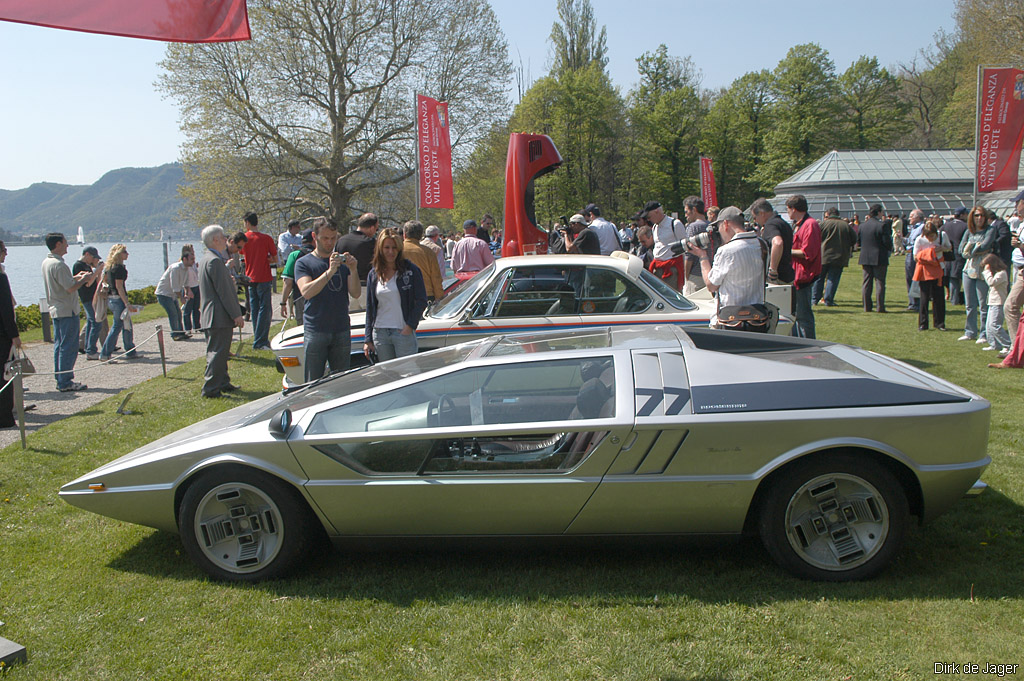

The Boomerang's unforgettable wedge-shaped body was the inspiration for some small-series Maseratis, for the Lotus Esprit-which nearly 30 years after its launch is still being produced-and significantly for the hugely popular Golf 1 that was marketed in 1974. Since then, the Boomerang has been invited to all major events in the world, including Pebble Beach, and has deservedly won numerous awards. After a careful restoration, it reappeared for the first time in the 1990 Bagatelle Concours in Paris, where Giorgetto Giugiaro was a judge and proudly hand-signed the rear panel. He had seen the car eight years earlier and was only able to purchase a model of it. The present owner discovered it there during a holiday trip in 1980 and could not resist buying it. After the Barcelona show in 1974, the Boomerang remained in Spain and was eventually sold to a cabaret owner in Benidorm. The car was shown at the Paris, London and Barcelona motor shows and was unanimously praised for its audacity. One journalist observed it looked as though it was doing 100 miles per hour standing still. With its 4.7-liter V8 engine developing 310 horsepower, the Boomerang was good for an indicated top speed of 185 miles per hour. The mechanicals were borrowed from the Maserati Bora. By the Geneva show in March,1972, it had been transformed into a fully operational vehicle. Now more than ever, Maserati is unique for its design and innovative by nature, and with the MC20 super sports car, the new Grecale SUV and the Nettuno engine, is a patented synonym for the technological revolution.Giugiaro's Maserati Boomerang was first displayed as a non-functional model at the Turin motor show in 1971. It continued the tradition of Maserati as a brand capable of creating unique automotive concepts, iconic and avant-garde cars that acted as pioneers of technology and style. Maserati Boomerang, considered by many to be a genuine work of art, was revolutionary and managed to influence the designs of successive cars.

It would change hands between various owners, ended up featuring in a number of auctions, and was even used in commercials. The only specimen of the Boomerang ever produced also made other appearances in international competitions. It was extremely modern in terms of its interior, where the dashboard instruments were built into the spokeless steering wheel and the seats were positioned very low. The retractable square headlamps stood out in the front, alongside the horizontal lights in the rear. The original windows, especially on the two doors, were interspersed with a strip of metal. The model was designed along a horizontal line that divided the car in two, with a sloping windscreen and a panoramic sunroof.

The originality of the Boomerang from an aesthetic point of view was demonstrated in its wedge shape and in its bold, clear lines, which conveyed an image of penetration, power and speed. Instead, it left behind a stylistic legacy that continued to live on not only in Giugiaro’s later creations, but also in other projects, serving as inspiration for various other automakers in Europe and the United States. The two-seater sports coupe never went into production. The rear-wheel drive had a five-speed gearbox. It could unleash 310hp, bringing it close to a top speed of almost 300km/h. The base used by Italdesign (chassis and complete mechanics) was a Maserati Bora, with a central eight-cylinder rear engine laid out at 90° that delivered 4 719cc. Only one model was ever made, which would be presented at the Swiss show in 1972 as a registered vehicle that ran perfectly. Maserati Boomerang, a mockup of which made a fleeting appearance at the 1971 Turin Motor Show. It was a concept created by the renowned hand of Giorgetto Giugiaro and produced by Italdesign. Half a century has passed since March 9, 1972, when the Maserati Boomerang made its debut at the Geneva Motor Show. A dream car, an extreme, futuristic, almost irrational, definitely beautiful model capable of remaining imprinted in the memory of every single fan.


 0 kommentar(er)
0 kommentar(er)
